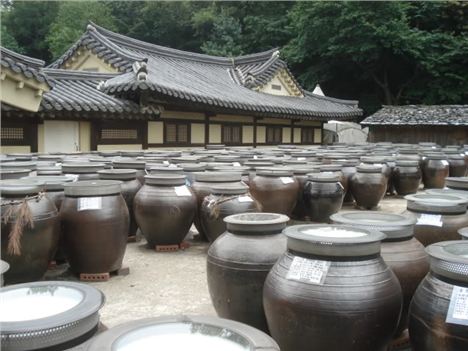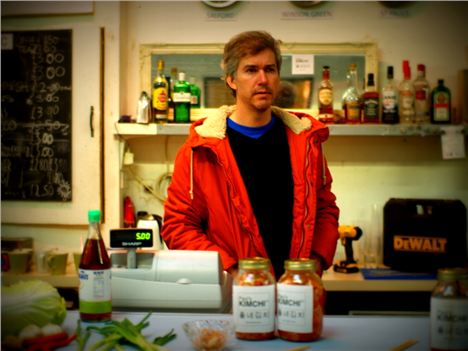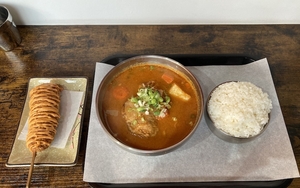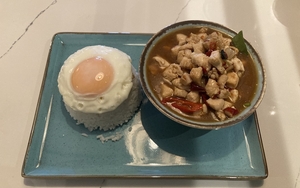MOST people have come to associate South Korea with either its crazy pop music or its ongoing feud with North Korea.
For those in the know, it's all about its cuisine - one of the most underrated in the world and generally shouldered out by the likes of Japanese, Chinese and Thai.
Now Static gallery is cementing – or should that be fermenting – another link - with Korea's national dish, kimchi.
Korean cooking is punchy and lively – just like its people – and dishes are bold, spicy and bursting with flavour. But go there and the aroma of kimchi – a rarefied cocktail of cabbage, chill paste, garlic and fish sauce – pervades all: trains, streets, parks, markets, bars.
Noodle Bar
This ubiquitous dish has inspired Paul Sullivan, owner of Static Gallery, to embark on a culinary adventure - Paul’s Kimchi Co.
Sullivan’s love of kimchi began in 2006 after a visit to Seoul and its bustling Namdaemum Market. So impressed was he that when he came home he set up a Noodle Bar project at the Roscoe Lane gallery.
It brought Korean food to Liverpool for possibly the first time and there were no half measures.
Sullivan advertised in Korean newspapers and a family from Seoul was recruited and flown over to Liverpool to cook. The UK Border Control folks quickly became interested, as did the council who denied the bar, situated in an outside container, planning permission.
But where others might have thrown in the towel at this point, Sullivan adopted some creative thinking. Thus the family of Korean chefs found themselves thousands of miles from home and breaking ground they never thought possible: they, and their restaurant, were declared an art installation.
Now Sullivan is ready for another course and this time he is getting stuck in himself. He has established a kimchi making facility at the gallery, a chopstick's throw from Chinatown, which will see its first franchise at the famous Vanabbe Museum in Eindhoven, Holland this month.
Roughly from December, "people will be able to pop into Static and buy or place orders for kimchi,” he says. “Paul’s Kimchi Co. will also be supplying a number of restaurants.”
South Korea’s food culture is one of the most unique in the world, wrought from the country’s rich history and traditional etiquette. Koreans are passionate about their food, and the connection between food and society is one of their uppermost values.
Sullivan says: “I was fascinated by the sharing food culture, and the almost ritualistic nature in which kimchi is essential to every meal.”
He plans to use clay pots and explore the true versatility of kimchi. A key part of his vision is to experiment and develop his own unique variations and dishes.
He says he will be sourcing his fish from Mersey waters and cabbage from local farmers to give his kimchi a special spin.
For a city that loves oriental flavours, it is surprising that Korean food hasn’t arrived here sooner. Already taking the likes of New York, Los Angeles and London by storm, Korean cuisine is the new thing, the new sushi.
However, it being Static, there is more.
Says Sullivan: “Static Gallery will be hosting a number of Korean events, such as film nights, and we will also be showcasing a wealth of exciting Korean dishes while exploring the fascinating world of Korean arts and culture.”
Kimchi crazy
 Static could soon look like this
Static could soon look like this
SO why so crazy about kimchi? This spicy, aromatic dish, made with cabbage, chill paste, garlic and fish sauce is the cornerstone of Korean cuisine, and a huge part of their natural cultural identity. It is an indispensible part of the diet, served with every meal and found at every table. An average 95% of Seoulites eat kimchi more than once a day, and the country consumes a whopping two million tonnes each year.
There are over 100 estimated varieties of kimchi, yet every type is different, depending upon the region and season in which it was produced.
Kimchi making, a process known as Kimjang, traditionally begins late October to early November, and is a family, communal effort that typically lasts two to three days. Traditionally, kimchi is a part of banchan – the collective term for the small side dishes served with most Korean meals, and what’s more, it is incredibly versatile: the older stuff is used to make soup, stews (jjigae) and rice dishes (bibimbap) literally meanimg ‘mixed rice’.
Traditionally, kimchi is fermented in large clay pots and stored underground to maintain a consistent temperature and retain flavour. It can spend months and even years underground before it is eaten. Nowadays, the likes of Samsung have created snazzy ‘kimchi’ fridges, found in every modern Korean household, and Sullivan will be using similar catering style fridges for his.















